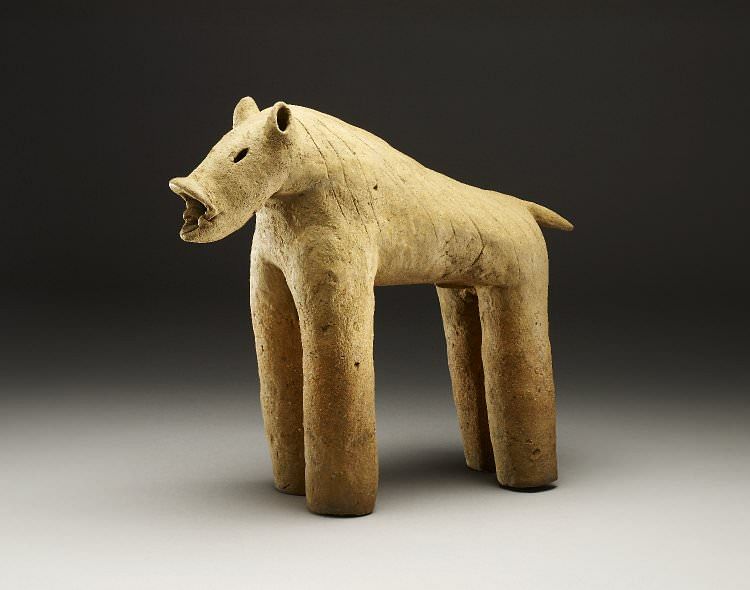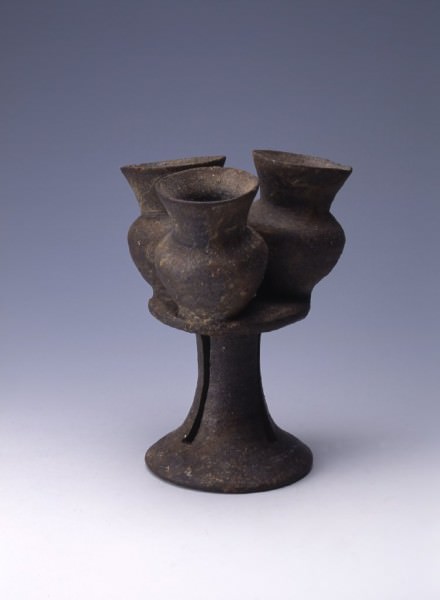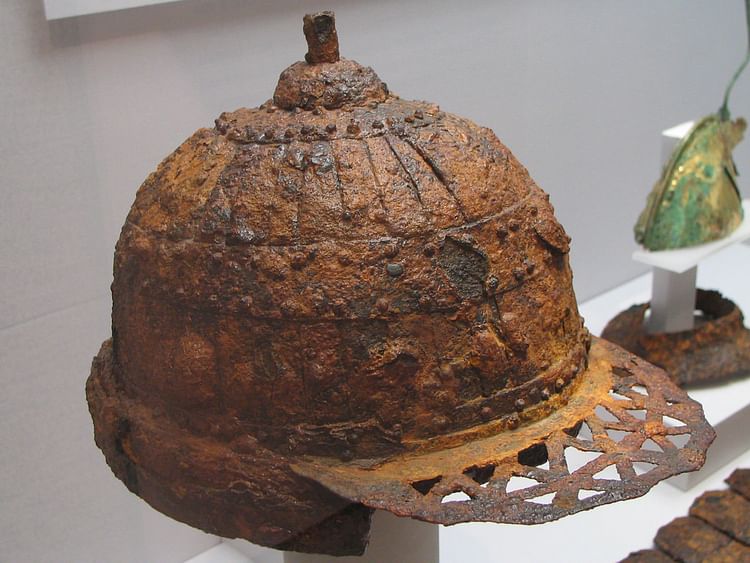Kofun Period › Gaya » Ancient origins
Articles and Definitions › Contents
- Kofun Period › Ancient History
- Gaya › Ancient History
Ancient civilizations › Historical and archaeological sites
Kofun Period › Ancient History
Definition and Origins

Following the Yayoi Period of Japan when farming and metalworking techniques were introduced from mainland Asia was the Kofun Period (c. 250 CE - 538 CE) where the religion of Shinto emerges from the beliefs of previous eras and the Yamato Clan rise to power and eventually become the imperial family. The period is named after the style of burial mounds used during this time.
BURIAL MOUNDS
The period is marked by the use of burial mounds erected for the elite, varying in size and shape from round or square mounds several meters long to a few hundred meter long keyhole shaped ones. Early tombs were simple, they only had the coffin buried in the summit of the mound or inside a stone chamber, but later in the period burial goods were also placed in the tomb, such as weapons, trinkets, or other personal items depending on status. The most powerful people had thousands of pieces buried with them inside separate mounds made exclusively for that purpose. Some of the early burial mounds were made from natural hills but by the 400's CE more and more mounds were made by building a mound on flat ground and featuring a moat. In the late Kofun Period, burial mounds became smaller and more widely used by people of lower status, with groups of 15-meter mounds forming cemeteries. The earliest Kofun were found in central Honshu around the modern-day prefectures of Kyoto, Nara, and Osaka. These cemeteries date from the early years of the 4th century CE but they would later spread to Kyushu in the south and to the northern and eastern areas of Honshu in the second half of the 4th century CE. Burial mounds show distinct features based on both status and region.
POTTERY
One of the most impressive developments in Kofun Period pottery was the appearance of Haniwa, funeral sculptures, which depicted decorated horses, fully armed warriors, well-dressed nobles, farmers, and dancers. These sculptures were placed inside burial mounds and tombs in general as offerings.

Sueki Stoneware from the Kofun Period
Pottery items intended for everyday use were produced in the Sueki style, which was a huge improvement compared to the previous styles used in the Yayoi and Jomon Periods as they were made of blue-green clay, formed on a potter's wheel, and fired in a kiln at temperatures of around 1,000 to 1,200 Celsius, the same temperature modern pottery is fired at.
TECHNOLOGY
The technology used during this period is, for the most part, the same as the technology used in the preceding period, although it is from this time that technology becomes more sophisticated. Rice paddies began to be constructed at higher elevations, irrigation systems became more complex, and ironworking became more widespread and intricate. Iron eventually replaced bronze as the metal of choice for tools and weapons as the tin needed for bronze was already hard to come by and was by that period even more scarce. Iron, on the other hand, was plentiful and would eventually become the much stronger steel used in later times.
SHINTO
THE WORD SHINTO TRANSLATES AS 'THE WAY OF THE GODS' & IT FOCUSES ON DILIGENT RITUAL PERFORMANCE TO MAINTAIN A PROPER LIFESTYLE AS WELL AS A CONNECTION TO THE GODS.
Although Shinto emerges during this period its development is rooted in previous eras such as the Yayoi when the worship of gods was first practiced. The word Shinto translates as 'the way of the gods' and it focuses on diligent ritual performance to maintain a proper lifestyle as well as a connection to the gods, or Kami as they are called in Japanese. The Kami are gods or spirits who embody natural powers such as the sea, sun, wind, storms, moon, as well as things like war or the underworld.Although most Kami were associated with nature, some were people, living or dead, sometimes even objects, if they had the proper qualities such as emperors, warriors, or other great people. At first, no special buildings, like temples or shrines, were needed to worship the Kami and any prayers or worship would be done out in the open or by sacred locations like forests by anyone who cared to. It was later that Kami would be worshipped in temples and dedicated shrines by clan chiefs or priests.These Shinto shrines were usually marked by a torii gate. The Kami were not believed to have lived in the shrine, temple, or sacred spot that was dedicated to them but rather it was thought they visited these locations and occupied a statue or figure that depicted them.
RISE OF THE YAMATO
Before the Yamato came to power clans would conflict with one another over power. They would become rivals as well as form alliances, using various tactics to try and achieve their goals but no one clan or group of clans would achieve the same amount of power. During the 5th century CE, one family of clans would rise to dominance over the Japanese islands of Honshu and Kyushu. The original seat of power for this clan was the modern-day prefectures of Kyoto, Nara, and Osaka. Each of the clans was governed by an elder male who would perform ceremonies to honor and appease the Kami and ensure the well-being of the clan and their continued dominance. Clan members were of the aristocracy, who at the end of the period would rise up and become the beginning of the imperial family.

Haniwa
It was through alliances with other clans, tribes, and confederations, the expanded use of iron, and the capability to marshal their people effectively that the Yamato were an effective military power. Although the Yamato were known to have military supremacy during the period, they tried to avoid war if they could and instead tried to form alliances with other clans by offering them a place in the political system or, when that failed, resorted to threats and forced the other clans into agreement. The major clans that supported the Yamato, like the Soga, Mononobe, Nakatomi, Kasuga, Ki, Otomo, and Haji, were called the ujiand would be ranked or titled according to their level of kinship or service. Below the uji were the be groups, which were occupational groups consisting of papermakers, scribes, and blacksmiths, among other occupations. Included in the uji and bewere some immigrants from China and Korea who had skills in wanted professions, such as metalworking or papermaking. At the bottom was the slave group, members of which were either prisoners of war or those born into that position.
RELATIONS WITH CHINA & KOREA
It is believed that the Yamato Clans of Japan established diplomatic relations with the Paekche Kingdom in Korea in 366 CE and had an outpost in the south which they governed until they were ousted by the Silla Kingdom in 562 CE. According to some Chinese records, between 413 CE and 478 CE five Japanese kings sent nine ambassadors with tributes to China in order to gain support in the Korean peninsula. While China would receive tribute through Korea from Japan, Japan itself would receive immigrants from China and Korea who would bring along with them their skills and knowledge which the Japanese treasured so as to keep on improving their culture.
TRANSITION TO THE ASUKA
By the end of the period, the Yamato had grown in power and become the Imperial House of Japan, contact with China and Korea increased, and Shinto had made its appearance. The transition to the next period, the Asuka Period (538-710 CE), was marked by the introduction of Buddhism, adoption of Chinese characters as a writing system (as the Japanese natives did not have a writing system of their own) and the adoption of many other aspects of Chinese society since they found the Chinese to be civilized, advanced and wished to be perceived in the same way.
Gaya › Ancient History
Definition and Origins

Gaya (aka Kaya or Karak) was a confederation which ruled central-southern Korea during the Three Kingdoms period from the 1st to 6th century CE. The peninsula was dominated by Gaya's more powerful neighbouring kingdoms of Goguryeo ( Koguryo ), Baekje ( Paekche ), and Silla, but Gaya, often the forgotten entity in this period, was nevertheless rich in iron ore and their craftsmen became highly skilled at fashioning iron objects such as armour and weapons. The high level of culture achieved by the Gaya states would influence Japan, their most important trading partner. The confederation came to a definitive end when it was fully conquered by the Silla kingdom in 562 CE.
FOUNDATION
The traditional dates for the Gaya confederacy are 42-532 CE, however, modern historians prefer to emphasise the entity's more certain existence from the 2nd century CE. The confederation consisted of six tribes, the most powerful of which were the Tae Kaya and Kuya tribes, with the latter later known as the Pon Kaya ('Original'). These had developed from the original 12 states of Pyonhan. The overall area of Gaya control was west of the Naktong River and south of Mt. Kaya. The capital was established at Pon Kaya.
THE GAYA CONFEDERATION PRODUCED FINE IRONWORK, INFLUENTIAL STONEWARE, & THE CELEBRATED STRINGED INSTRUMENT THE GAYAGEUM.
PROSPERITY
The Gaya confederation prospered due to its fertile agricultural lands, maritime trade, and above all, its rich iron ore deposits.There are few details available on the working of the Gaya states or daily life, but we can imagine a similar model to the contemporary Three Kingdoms where a royal family dominated a hierarchical aristocracy which, in turn, governed the provinces dominated by a farming peasantry.

Three Kingdoms of Korea
COLLAPSE
Throughout their history, the Gaya states were constantly harassed by their neighbours the Silla and Baekje kingdoms and consequently never had the opportunity to form a more centralised state which political stability might have permitted. From the mid-4th century CE, Baekje became more territorial ambitious during the reign of King Kun Chogo and attacked Gaya lands. Then when the Silla kingdom expanded in the 6th century CE, Gaya's alliance with Baekje did it no good at all and Pon Kaya was conquered and destroyed (532 CE), as was Tae Kaya (562 CE) and the other important Gaya towns. The Gaya confederation was no more.
RELATIONS WITH JAPAN & CHINA
Ties with the Wa (Wae) of Japan were particularly close, and scholars continue to debate which culture more influenced the other. The issue is coloured by nationalistic bias so that some historians claim that Gaya was a Japanese colony while others propose that horse riders from the Eurasian steppe came to Japan via Gaya and introduced the burial tumulus to that culture.Evidence is lacking either way, although most scholars agree that the Gaya was the more advanced culture and recent finds of iron horse armour, notably from the 5th century CE tomb at Pokchon-dong, suggest that the Gaya did master the use of that animal. More certain is that iron was the most important Gaya export to Japan. Early relations with Han China is evidenced by 1st-century CE Chinese coin finds at Pon Kaya and by the presence of the sloping kiln used by Gaya potters.

Gold Gaya Crown
ART & ARCHITECTURE
Gaya artists produced grey stoneware clay pottery in the form of stemmed cups, horn-shaped cups, tall jars with pierced stems, and spouted vessels in the form of ducks, shoes, warriors, boats, and even houses. Stoneware requires a high firing temperature, and this technology was, no doubt, connected to the furnaces required to produce iron. Gaya potters likely passed on this innovation to Japan where the famous sueki (or sue ) stoneware would be produced as a result.
Objects were also made of silver and gold by Gaya craftsmen, including high and intricate crowns. Gaya iron products include swords, riveted body armour, helmets, and arrowheads. These were so esteemed as to be exported to the north-east region of Korea, China and Japan. Another successful export was the gayageum ( kayagum ), a zither with 12 silk strings thought to have been invented by King Kasil in the 6th century CE, which would be taken up by musicians in Japan and which remains a potent symbol of Korean culture even today.
The Gaya region is rich in tombs; over 1,000 have been identified at Pon Kaya alone. In the 4th century CE, the tombs of the Gaya typically took the form of rectangular or oval pit graves set into natural mounds. From the mid-5th century CE, the Gaya constructed stone chamber tombs with later examples having a horizontal entrance. As already mentioned, many tombs have equestrian equipment such as iron armour, saddle parts, bits, and stirrups suggesting the horse was an important part of Gaya culture and warfare.
This article was made possible with generous support from the British Korean Society.
LICENSE:
Article based on information obtained from these sources:with permission from the Website Ancient History Encyclopedia
Content is available under License Creative Commons: Attribution-NonCommercial-ShareAlike 3.0 Unported. CC-BY-NC-SA License